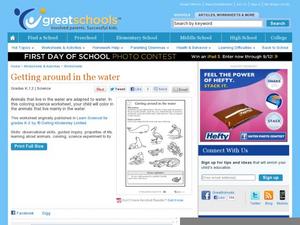Nemours KidsHealth
Food Allergies: Grades 6-8
Over two lessons, scholars use articles and discussions to define what a food allergy is and identify the most common food allergens. Small groups prepare a skit showcasing how the body exhibits an allergic reaction. Learners examine...
Howard Hughes Medical Institute
Sorting Seashells
Scientists use morphological, physiological, and molecular information to continually revise organism classification. Scholars observe and learn about 20 shells. Then, they work to sort and classify the shells, building a taxonomy based...
NOAA
Seafood and Human Health
Whether your young biologists realize it or not, humans play a significant role in marine ecosystems. To help them understand this fact children first create graphical representations that show homo sapiens' place in marine food chains,...
NOAA
An Ocean of Energy
Young biologists trace the path of the sun's energy through marine ecosystems in the second part of this four-lesson series. Building on prior knowledge about producers, consumers, and decomposers young scholars are introduced to the...
NOAA
Understanding Food Chains and Food Webs
Jump into an exploration of marine ecosystems with the first lesson in this four-part series. After first learning about crustaceans, mollusks, and other forms of sea life, young marine biologists view a PowerPoint presentation that...
Curated OER
Getting Around in the Water
Young scientists who are learning about the variety of environments that animals live in use a activity in order to choose animals that live, primarily, in water environments. There are eight pictures on the activity, and learners must...
Curated OER
Marine Fisheries Management
Almost 200 slides make this a vast collection! It is a quirky collection, titled "Marine Fisheries Management," but having little to do with that occupation. What you will find are two-toned blue backgrounds with no pictures, but a few...
Curated OER
Something's Fishy. . . Classes and Qualities of Fish and Seafood
If you are going to eat seafood, it helps to understand the different classifications. In this presentation, viewers learn to differentiate two types of finfish and the variations of edible shellfish. They also examine the...
Curated OER
Net Results
Students investigate through role play how decisions by watermen, recreational fisherpeople, and lawmakers influence and are influenced by economics and the abundance or scarcity of fish and shellfish stocks. They consider social,...
Curated OER
Clam Hooping
Students explore ocean biology by capturing organisms on a beach. In this clam collecting lesson, students identify the clam species and discuss the anatomy of a clam as well as the importance they provide as a meal. Students utilize a...
Curated OER
Crawdad Grab
Students explore biology by conducting a freshwater fishing activity. In this crawdad instructional activity, students discuss what a crawdad is, where they are found and how they can be prepared as a meal. Students utilize string,...
Curated OER
Shellfish Shenanigans
Twelfth graders create simulations of a reality-based TV show that investigates the near death of a contestant from a seafood meal. They examine the physical symptoms of anaphylactic shock, and create protein fingerprints.













